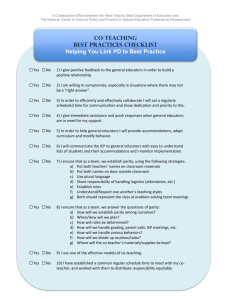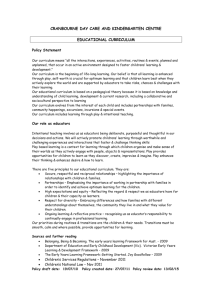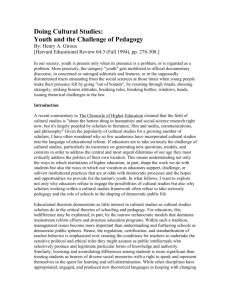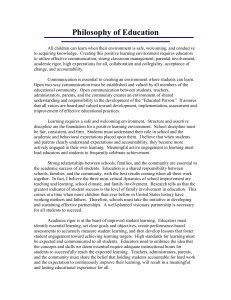Submission cover sheet - Barriers to Effective Climate Change
advertisement
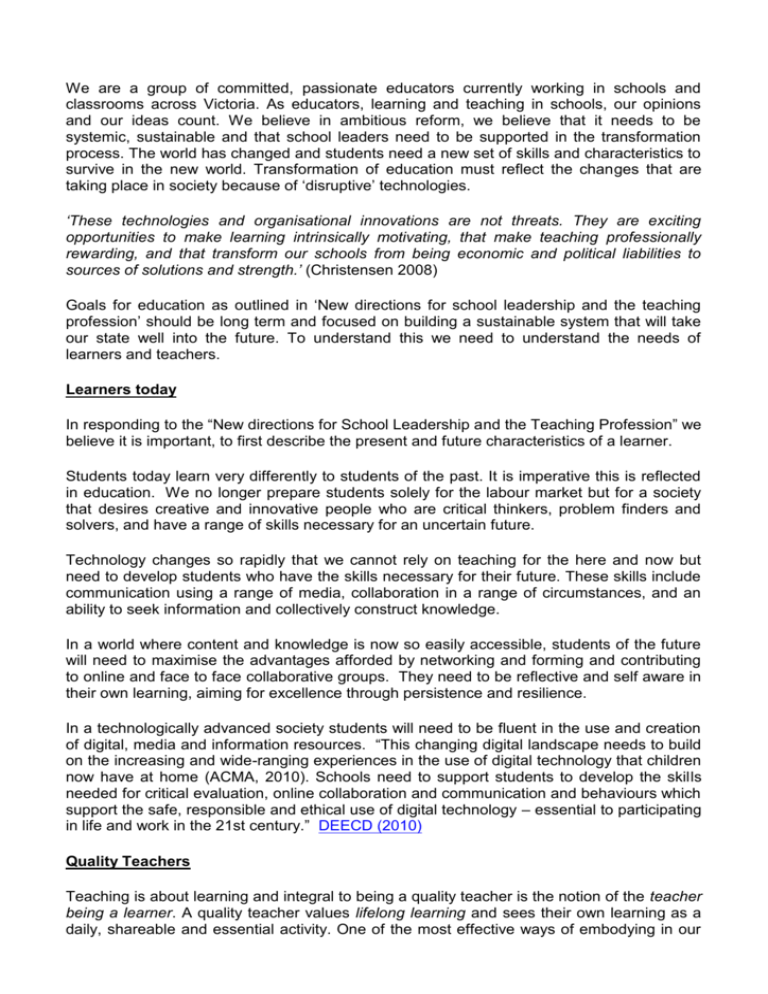
We are a group of committed, passionate educators currently working in schools and classrooms across Victoria. As educators, learning and teaching in schools, our opinions and our ideas count. We believe in ambitious reform, we believe that it needs to be systemic, sustainable and that school leaders need to be supported in the transformation process. The world has changed and students need a new set of skills and characteristics to survive in the new world. Transformation of education must reflect the changes that are taking place in society because of ‘disruptive’ technologies. ‘These technologies and organisational innovations are not threats. They are exciting opportunities to make learning intrinsically motivating, that make teaching professionally rewarding, and that transform our schools from being economic and political liabilities to sources of solutions and strength.’ (Christensen 2008) Goals for education as outlined in ‘New directions for school leadership and the teaching profession’ should be long term and focused on building a sustainable system that will take our state well into the future. To understand this we need to understand the needs of learners and teachers. Learners today In responding to the “New directions for School Leadership and the Teaching Profession” we believe it is important, to first describe the present and future characteristics of a learner. Students today learn very differently to students of the past. It is imperative this is reflected in education. We no longer prepare students solely for the labour market but for a society that desires creative and innovative people who are critical thinkers, problem finders and solvers, and have a range of skills necessary for an uncertain future. Technology changes so rapidly that we cannot rely on teaching for the here and now but need to develop students who have the skills necessary for their future. These skills include communication using a range of media, collaboration in a range of circumstances, and an ability to seek information and collectively construct knowledge. In a world where content and knowledge is now so easily accessible, students of the future will need to maximise the advantages afforded by networking and forming and contributing to online and face to face collaborative groups. They need to be reflective and self aware in their own learning, aiming for excellence through persistence and resilience. In a technologically advanced society students will need to be fluent in the use and creation of digital, media and information resources. “This changing digital landscape needs to build on the increasing and wide-ranging experiences in the use of digital technology that children now have at home (ACMA, 2010). Schools need to support students to develop the skills needed for critical evaluation, online collaboration and communication and behaviours which support the safe, responsible and ethical use of digital technology – essential to participating in life and work in the 21st century.” DEECD (2010) Quality Teachers Teaching is about learning and integral to being a quality teacher is the notion of the teacher being a learner. A quality teacher values lifelong learning and sees their own learning as a daily, shareable and essential activity. One of the most effective ways of embodying in our students what it means to be a learner is to actually model the disposition itself (Tishman 1992). The efficacy of this depends on the teacher having the time and space to reflect on their own learning. A quality teacher needs to be able to share their learning in a supportive and collaborative environment. Provided with these conditions, a quality teacher will individually and collaboratively build the skills to provide learning that is autonomous, inquiry-based, self-directed and collective in nature (Olsen 2012). A quality teacher is a connected teacher. The transformative and disruptive effects of technology on our society should be reflected in our education system. No longer is the world’s information held captive in libraries or books and only accessed by a privileged few. Ubiquitous fast access to the world’s information through the internet has changed the way in which schools, learners and teachers operate. The idea of a teacher delivering and transferring content has been disrupted. Large learning communities of educators are connecting through Web 2.0 tools such as blogs, Twitter, Facebook and Google Plus. There are numerous examples of dedicated modern educators participating in daily and weekly conversations about education, sharing ideas and resources through Twitter hashtags such as #vicPLN (Victorian Personal Learning Network) #edchat (Education Chat) #pbl (Project Based Learning). This very submission has been constructed using our own #PLNaction twitter hashtag and blog. Quality teaching comes from the time, opportunities and inclination to be an inquirer and a learner. The “New Directions for School Leadership and Teaching Profession” states there are many great teachers working in Victorian schools at present, achieving outstanding successes in education, motivating and inspiring young Victorians. We would agree, the teaching profession is full of quality teachers already, so how do we take the next step to lift the performance of Victorian students? How do we change the way we evaluate and assess students to reflect learning in a technological and creative world? Supporting innovation in education, school structures and provision of effective professional learning are the priorities that we, as practicing educators, believe are essential in transforming education and providing a system that will take us well into the future. 1. Supporting Innovation in education. Supporting educational innovation is essential for empowering teachers to be creative, build on capacity and generate new ideas. When we support teachers to be innovative they become the change agents for schools and enhance student learning. Teachers need to be in control of their professional learning. Learning should be relevant, timely, collaborative and based on team and school needs. Teachers should be able to select inquiries and professional learning opportunities throughout the school year that are best placed to impact on student learning outcomes. School and wider educational structures need to be based on the support of innovation and creativity. Promote innovation in education to the wider community and build a trust in school leaders and the teaching profession to make decisions based on research, evidence and best practice. Create the expectation that all schools will be providing an education for the future and educational authorities should make it very clear that schools are supported as they work towards the transformational changes that are needed. For innovation to occur Principals need to be supported and to trust in teachers ability to choose, undertake and share professional learning that complements school based professional learning and is focused on a shared clear vision and goals. When goals and visions are produced they should be collaborated on and developed to meet the needs of individual schools rather than generic and system wide. Collaborative groups or committees should be based around the needs of the school, the teachers and the students and provide opportunities for teachers to actively participate in focused professional learning based on identified needs and passions. Innovation happens when teachers are enabled to work together to set individual and jointly negotiated Performance and Development goals and provided with the resources and support to achieve these goals. The timing, research area and focus of these goals should be negotiable dependent on the needs of the educators and the schools. Build capacity in school leaders to recognise, support and encourage innovation. Efficient time management within schools, creation of professional networks and use of ICT tools to create productive systems will allow time for professional learning teams to work for real in-school purposes. Consideration should be given to providing time for educators to take sabbaticals, or extended time to participate with other educators in extended professional reflections and discussions designed to further build knowledge, skills and understandings. Revisit and revise the necessity of meetings, data collection and traditional processes which are outdated and time consuming. 2. Structuring schools As acknowledged in the New Directions paper, moving forward requires bold and difficult reform. We are no longer teaching in the ‘factory model’ environment, the needs of our learners have changed, the demands of society have changed and the opportunities to network on a global scale have changed the nature of work. We cannot hope to provide a quality education in schools that are built on and following models from last century. Whilst we cannot always renew the physical spaces we can transform the way we use them. We need to be bold about reforming the structure of schools. This is not possible without support and trust from Education Departments and the wider community. We need to build an image that reflects the quality education Victorian teachers offer. We need to focus on regaining the trust of the community, through the active promotion of the 21st century learning that is happening in our schools. We need to ensure our schools are places of ‘real’ learning, and communicate our understandings of a viable and guaranteed curriculum to students, parents, society and all stakeholders in education. As knowledgeable and educated professionals we need to keep building our collective understanding of how people learn and educating others in this process. We need to start looking at options for structuring schools that move away from the traditional isolated classroom. School leaders need system wide support to re-envisage the structures within their schools. Schools should be built around collaborative teams working to achieve student learning outcomes. Structuring schools so teachers are working as teams, learning as teams, collaborating as teams.Teaching teams need to be provided with some autonomy to decide upon and plan professional learning to meet the needs of the team. Empower teachers and school leaders to innovate with ways of providing learning for students, use current research to support and promote innovators, recognise that one size does not fit all, we need to provide educational options for all students and teachers, within schools, across schools. Teachers are connected, this means a myriad of opportunities for professional learning, our energies need to be directed to developing communities of practice and supporting teachers to maximise the opportunities to work with colleagues across schools. Sharing knowledge and practice needs to be supported and enhanced. We have the tools. 3. Effective Professional Learning Learning should be through collaborative, connected networks. For teaching to have an impact on learning outcomes we have to move away from working in isolated silos and become collaborators – builders of collective knowledge – and work together to improve the educational (social, emotional, physical, spiritual) outcomes for our students. It is only through taking collective responsibility for the building high performing schools and being creative in the ways we provide opportunities for teachers to work together in schools that we can achieve improved outcomes. Leverage the use of technology for facilitating collaboration – by enabling educators to access and build connections, ideas, resources and thinking beyond their classroom and beyond their school. This in turn promotes system wide innovation through the sharing of knowledge, skills and understandings. Recognise and actively promote the concept that the effective professional learning is workplace, job embedded and collaborative. By enabling teachers to build professional learning communities that select appropriate areas for investigation and research, we are building collective responsibility for improving student learning outcomes. Teachers should be in control of their Professional Learning. Teachers should be able to select inquiries and professional learning opportunities throughout the school year that are relevant, timely, meet school needs and are best placed to impact on student learning outcomes. We need to find ways to maximise time for teachers to learn together in schools. We need to question how schools have been structured in the past (timetables, single classes, who is teaching, who is learning, structure of schools, spaces and environment, traditional roles). If we value collaboration and collective knowledge in building educators we need to be supported to change the way access to professional learning is currently available. We need practitioner led research and action research to be valued, funded, supported, and time enabled. If we want teachers to be action researchers, driving innovation and system improvement we have to provide them with the skills to build their capacity and confidence. The paper is clearly stating the importance of high quality, well educated teachers. This should be supported with opportunities such as funded placements for postgraduate studies. We want to emphatically make the statement that we do not believe in the merits of performance pay and that it has not proved to be an effective measure in improving the quality of teaching. Performance pay and collaboration are enemies; teachers will not share and learn with other teachers if they are being paid based on their individual performance. Performance pay is divisive and only places value on that which is measurable. We would suggest that there could be review of pay scales so that options are provided for differing career paths and recognition that not all experienced and effective classroom practitioners want to take on levels of responsibility or leadership. Options should provide educators with choices of direction. We are enthusiastic and optimistic about the future of education and believe if we make bold reform in education in Victoria we can build a future of creative, forward thinking learners who will have the skills and confidence to prosper in Victoria, Australia and the world. We believe that the future of education and reform needs to begin with those who are in classrooms, creating learning opportunities for students and working hard to build their capacity -– teachers. We would welcome an opportunity to offer our ideas, knowledge and understanding of learning to build reform in Victorian Education. References: Christensen, C. M., Horn, M. B., & Johnson, C. W. (2008). Disrupting class, how disruptive innovation will change the way the world learns. New York: McGraw-Hill Professional. Department Of Education and Early Childhood Development Digital Learning Statement 2010 Olsen R. What should students do once they can read? Richard Olsen Blog, Retrieved August 26 2012, http://www.richardolsen.me/b/2012/08/what-should-students-do-once-they-can-read Tishman S, Jay E, Perkins D, (1992). Teaching Thinking Dispositions: From Transmission to Enculturation, Harvard University http://bit.ly/plnactionsupporters is a link to a list of educators who have collaborated in the creation of the submission and support it.

